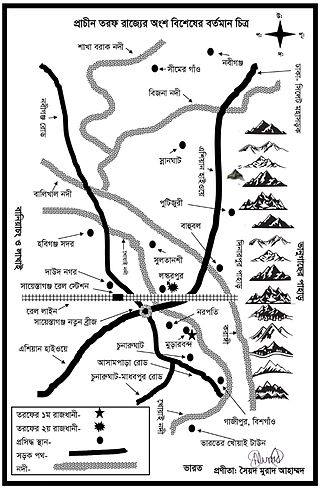Dharma Manikya I, also known as Dangar Fa, was the Maharaja of Tripura from 1431 to 1462. His reign was notable for its territorial expansions as well as for his religious and cultural contributions.
Maha Manikya, also known as Chhengthung Fa, was the Maharaja of Tripura from about 1400 to 1431. Contrary to narratives provided by early histories, evidence indicates that Maha Manikya was the founder of the kingdom, having established dominance over neighbouring tribes in the early 15th century. He is further thought to be the first holder of the title "Manikya", taken in recognition of a historic victory over the neighbouring Bengal Sultanate. The dynasty which he founded continued using the title until Tripura's merger with India in 1949.
Yashodhar Manikya, also known as Jashodhar Manikya, was the Maharaja of Tripura from 1600 to 1618. His reign is considered to be the nadir of the kingdom's history, with the temporary overthrowing of the monarchy and the region's incorporation into the Mughal Empire.
Kalyan Manikya was the Maharaja of Tripura from 1626 to 1660. Reigning in the aftermath of an occupation by the Mughal Empire, Kalyan did much to restore the kingdom, though it remained in a continuous state of war with the Mughals.

Vijaya Manikya II, also spelt Vijay or Bijoy, was the Maharaja of Tripura from 1532 to 1563. Succeeding to the throne at a young age, Vijaya proved himself to be a formidable military leader, initiating a series of conquests into several surrounding kingdoms, including the powerful Bengal Sultanate. During Vijaya's reign, the might and influence of Tripura reached its zenith, leading to him being viewed as one of its greatest monarchs.
Deva Manikya, also spelt Deb Manikya, was the Maharaja of Tripura from 1520 to 1530. A son of the famous Dhanya Manikya, Deva initially continued his father's legacy of military conquests, though he ultimately proved to be less successful. A religiously zealous monarch, he was eventually killed in a conspiracy orchestrated by his spiritual guru.
Narendra Manikya was the Maharaja of Tripura from 1693 to 1695.
Mukunda Manikya was the Maharaja of Tripura from 1729 to 1739.
Ratna Manikya II was the Maharaja of Tripura from 1685 to 1693 and again from 1695 to 1712.
Ishwar Manikya was briefly the Maharaja of Tripura at the close of the 16th century.
Ananta Manikya was the Maharaja of Tripura from 1563 to 1567. A weak monarch in comparison to his predecessor, he spent his reign under the control of his influential father-in-law. He died after only a few short years of rule, potentially at the latter's hands.
Udai Manikya I, also known as Gopi Prasad, was the Maharaja of Tripura from 1567 to 1572. Though from a lowly background, he later rose to become one of the most powerful figures in the kingdom. Following the death of the previous monarch, his son-in-law, Udai took royal power himself, for a time supplanting the ruling dynasty with his own line.
Joy Manikya I was the Maharaja of Tripura from 1573 to 1577.

Taraf, previously known as Tungachal, was a feudal territory of the Sylhet region in Bengal and was under many petty kingdoms in different periods of time. It was part of what is present-day Habiganj District in Bangladesh.
Amar Manikya was the Maharaja of Tripura from 1577 to 1586.
Joy Manikya II was the Maharaja of Tripura during the mid-18th-century. He originally gained the throne through popular approval for his military hostility to the Mughal Empire. However, Joy spent much of his reign warring against various relations to maintain his grip on it, in particular with his cousin Indra Manikya II.
Indra Manikya II was the Maharaja of Tripura during the mid-18th-century. His reign was spent struggling for control of the kingdom with his relative Joy Manikya II.
Udai Manikya II was the Maharaja of Tripura briefly during the mid-18th-century, having laid claim to the throne during a power struggle between his relatives Joy Manikya II and Indra Manikya II.

The Greater Noakhali region predominantly includes the districts of Noakhali, Feni and Lakshmipur in Bangladesh, though it has historically also included Bhola, Sandwip and some southern parts of Tripura in India and southern Comilla. The history of the Noakhali region begins with the existence of civilisation in the villages of Shilua and Bhulua. Bhulua became a focal point during the Buddhist and Hindu kingdoms of Pundra, Harikela and Samatata leading it to become the initial name of the region as a whole. The medieval Kingdom of Bhulua enjoyed autonomy under the Twipra Kingdom and Bengal Sultanate before being conquered by the Mughal Empire. At the beginning of the 17th century, Portuguese pirates led by Sebastian Gonzales took control of the ara but were later defeated by Governor Shaista Khan. Affected by floodwaters, the capital of the region was swiftly moved to a new place known as Noakhali, from which the region presently takes its name. By 1756, the British East India Company had dominated and started to establish several factories in the region. The headquarters was once again moved in 1951, to Maijdee, as a result of Noakhali town vanishing due to fluvial erosion.

The Kingdom of Bhulua was a kingdom and later a zamindari covering the present-day Noakhali region of Bangladesh. Its establishment is generally credited to Bishwambhar Sur, a Hindu Rajput of Mithila who passed by the area during a pilgrimage. The kingdom fell under Tripura vassalage in the 15th century, and was reduced to a zamindari (fiefdom) after losing to the Mughals. Most of the kingdom's land has been eroded by the Meghna River.




